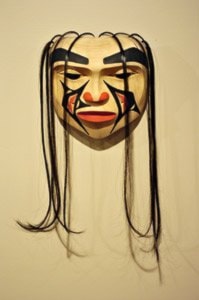Like sculptors through centuries, eight budding local artists released forms caught in raw chunks of cedar — masks, plaques, paddles and bowls.
Their tools were a simple hook knife, a straight knife, an adze, chisels, saws and sanders.
Once shaped, the pieces were painted with flat acrylic paint and embellished with horsehair and abalone.
The artists chipped, chiseled and painted until finely crafted crows, prancing moose and swooping hawks emerged from the grain.
The Service Canada-sponsored program teaches youth, aged 16 to 30, to be carvers.
Just halfway through the 41-week program, the group displayed its work at the Arts Underground on Main Street, in partnership with the Yukon Arts Society.
The show is dubbed Carving our Path: The Sundog Experience, a title coined by the program’s eight carvers.
It teaches apprentice artists every facet of the craft, from working with tools to working with taxes — they learn to write business plans, how to market art, how to price it, make business cards, keep accurate records and how to file taxes as an independent artist.
“You try to get commissions, try to get somebody who is interested in your style to make something for them in the future,” said participant Derrick Hastings at the show’s opening on March 3. He, and his wife Katie English, both from Ontario, will use the newly honed skills to start Autumn Dreams, a carving company named after their baby daughter, who was born last fall.
Another participant, 17-year-old William Skookum, hopes to make a career out of carving. He’s been working on his drawing skills since he was first able to hold a pencil.
For now he’s carving crow masks and finely painted paddles, but he’s working up to, one day, carving a canoe.
“Ever since I saw my grandpa carve out a big canoe, it sort of inspired me,” said Skookum.
“It gives me something to do because where I’m heading right now is probably nowhere,” he said. “I like doing this instead because it doesn’t feel like real work.”
“It seemed like a good opportunity to try something new,” said William’s cousin Justin Skookum, who had only tried woodworking in shop class before this course.
“It’s been a good program so far, I’ve learnt how to make things that I’ve always wanted to do.”
“The masks and plaques they have created are gorgeous, and bring them a great deal of pride,” said Heather Finton, owner of the Sundog Retreat and one of the program’s creators. “The new skills they are learning will carry them through to new success in their lives.”
During the program, the youth alternate working at the Sundog Retreat, which is located about 25 minutes outside of Whitehorse on the Mayo Road, and working by themselves.
“It’s for people who wouldn’t necessarily fit a traditional job or setting,” she added.
Finton, who developed the program with her husband, chose carving because artistic expression seems to fit well with the interests of the youth at risk, she says.
“The nice thing about carving is that it’s very portable,” said Finton. “And the Yukon has a lot of wood,” she added with a laugh.
Calvin Morberg, this year’s instructor, was offered the position after going through the program as a student for two years.
“A lot of people tonight expected me to be older,” Morberg, who is now 22 years old, said at the show’s opening. “When I first started carving, people, who I’d try to sell my work to, didn’t believe that I’d carved it,” he said.
But now, after a few years and a few shows, Morberg’s work is being displayed at local galleries.
Morberg is one of the program’s biggest success stories. He’s sold most of his carvings and has new commissions coming in all the time.
The program has worked for him, and now he wants to make it work for others.
“To pass on what I know, it’s a good feeling,” said Morberg.
“I wasn’t doing so good in my life, carving was kind of like my calling,” he said. “Since I started carving things have really picked up for me.”
William Callaghan, Arnold Elias and Terrance Clark are the other three fledgling carvers.
The whole project costs $150,000 a year to put on. About half the costs go towards a weekly $216 participant stipend and towards paying the instructor, said Finton.
Each participant also receives a toolkit with carving tools.
“It’s part of a sustainable way to make a living,” she added.
And it seems to be working — after the show’s opening night many of the artists had sold their work and had already received commissions to create more.
Carving Our Path: The Sundog Experience will be on display until March 24.
